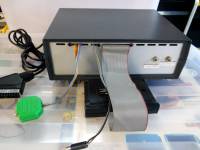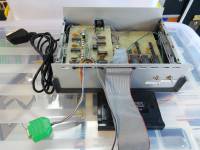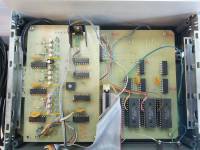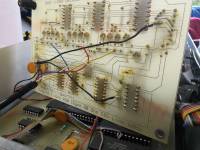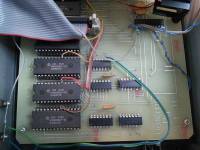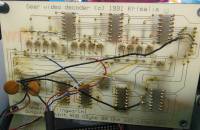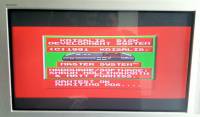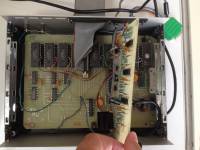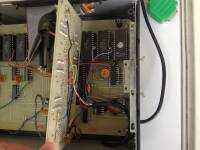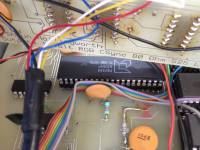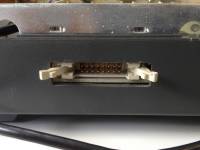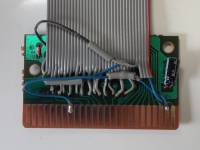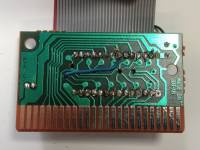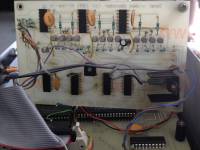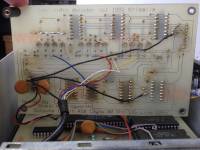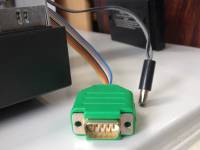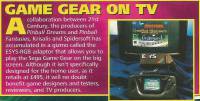|
|
ForumsSega Master System / Mark III / Game GearSG-1000 / SC-3000 / SF-7000 / OMV |
Home - Forums - Games - Scans - Maps - Cheats - Credits Music - Videos - Development - Hacks - Translations - Homebrew |
View topic - Krisalis Software - SMS/GG Dev Box
 |
| Author | Message |
|---|---|
|
Krisalis Software - SMS/GG Dev Box
|
|
I recently met up with a guy with a collection of dev. hardware ex. a UK studio and one of his items is quite interesting and I'm wondering if its an item anyone has seen before.
Note: URLs are fudged due to antispam :( http://farm6.staticflickr.com/5551/15313236035_c277b05782_c.jpg More detailed inside Pics here: http://www.flickr.com/photos/23778385@N07/sets/72157647817215536/ I know lots about Krisalis but was not aware they made dev. hardware. It is pretty handmade! The green plug is a 9 pin male din (Suspect it may connect to an RGB modded SMS?), it also has a ribbon cable type connector on one side (to connect to PC?) and a plug for power (9V?) on the other side No branding at all on the exterior but opening it up reveals boards clearly etched "(c) 1991 Krisalis", "Design by Shaun Hollingworth". "Design by S.L.H." One board is named "Gear Video Decoder - Outputs 1 volt RGB CSync 80 Ohm 525 Line 60Hz"." Suspect the green DIN may connect to an RGB modded SMS? The post here around Lemmings 2 from Matt Tailor around the Spidersoft ESYS system and Krisalis KASM tools seems related? |
|
|
|
|
|
|
I'd guess that board is for outputting the Game Gear display to a monitor/TV similar to this. SMS had RGB output as standard and was 50Hz in UK. |
|
|
|
|
|
|
I agree. The green plug (appears to be a D-sub rather than a DIN?) would have connected to a modified Game Gear, and the board would have done the necessary conversion to output video through the SCART cable. The other board appears to be a RAM cartridge (essentially a bigger version of this). The large ICs are 32KB SRAMs - there are perhaps 8 on the board giving a total of 256KB. These would be programmed somehow and then a Sega 8-bit machine could access them through the cartridge on the other end of the ribbon cable. Although the cartridge is sized for the Master System, it could be used with the Game Gear through a converter.
This box seems very similar to Spidersoft's ESYS box, although in this case the ROM emulator and video interface boards are both together. Matt Taylor mentions the KASM software having support for "debugging and breakpointing" - I wonder if the ESYS hardware had any special support for this? If so, this board (coming from the makers of KASM) probably has similar features. Do you have any photos of the rest of the larger circuit board? |
|
|
|
|
|
|
I'll try and carefully see if I can get better photo's of the bottom board, curious myself to see what else might be etched onto it. |
|
|
|
|
|
|
|
So much RAM. There are fly-wires on the bottom board leading to each of the /CS pins on the 62256 RAM chips. Those must go to the main memory mapper.
I did notice the phrase "GEAR VIDEO DECODER." Are you certain it is for SMS? There is an SMS cart, but GEAR is awfully suspicious. ;) |
|
|
|
|
|
|
|
I now know more about his unit is as I carefully powered it up today.
Plugged cart into SMS1 and power to Dev box. No output on the scart from box but from SMS get a lovely screen that says. "Krisalis 512k Development System. (C) 1991 Krisalis. Master System tm. Hardware/software Shaun Hollingsworth & Matt Furniss. Underneath it says: Ramtest OK. Awaiting PDS. . . . I've got pics of the screen but still can't post images here so will post kludged links later. Can a mod pleaae fix the earlier links? |
|
|
|
|
|
|
| I fixed the links. You should be able to post links and images from your 4th post now :) | |
|
|
|
|
|
| Image attachments should work for new users..? | |
|
|
|
|
|
|
Images of the screen when this is connected to an SMS,
Apologies for using a widescreen 16:9 TV for this - will recapture at correct 4:3 ratio later. 
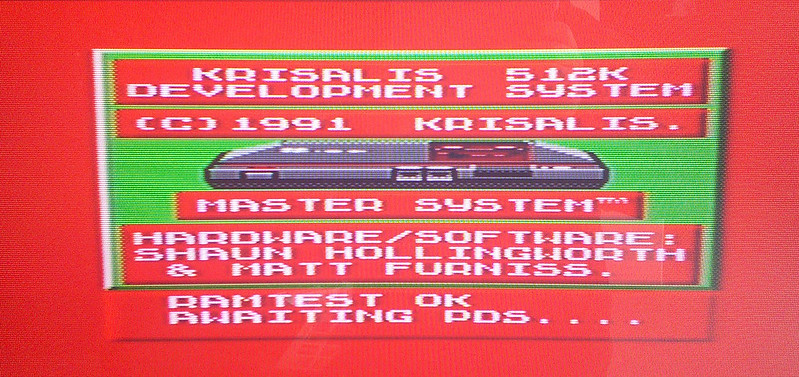
Suspect the unit can be used for both SMS and GG dev? |
|
|
|
|
|
|
That's a nice surprise - I wasn't expecting the box to still contain software. Do you think the owner of the box would be willing for a copy of the software to be made, and perhaps released publicly? I'm sure several people would be interested in what it does and how it works. |
|
|
|
|
|
|
Presume this is the "BIOS" of the unit, still unsure if the RAM has any data retained. Owner is interesting in getting it preserved, just unsure exactly how to go about it safely. |
|
|
|
|
|
|
| Can't location any EPROM on the photos (some section may be covered?) so I assume there's an EPROM with code inside the cartridge and the ribbon cartridge is a communication cable. | |
|
|
|
|
|
I would like to thank "radar" (again) for giving me the opportunity to investigate this development system in person. During our investigation we took many more photos, some of which are attached here. We also discovered the following:
This development system shares many similarities with Spidersoft's ESYS (described by Matt Taylor), including apparent support for easily swapping the ribbon cable and cartridge for use on a different system. In fact, we discussed the possibility that this box is ESYS. Matt mentioned that Krisalis wrote the software for ESYS - perhaps they were also subcontracted to build the hardware. However, there is at least one difference between this box and Matt's - this box does not appear to have a battery backup for the SRAM. We attempted to dump the unit's BIOS using a Retrode, but were unsuccessful. I am currently investigating alternative approaches. |
|
|
|
|
|
|
| Shaun Hollingsworth and Matt Furniss seems to have been a chiptune development duo. Hollingsworth as the sound programmer/coder, and Furniss as the composer. I guess some game dev. guys were pretty all-round in those days... :) | |
|
|
|
|
|
|
Put some electrical tape over that UV EPROM NOW!
Put some electrical tape over that UV EPROM NOW! The device 'could be' using a custom bank switching scheme of which the retrode cannot understand. Looking at the enormous amount of RAM, it could very well be the case. The 27c256 is socketed however, so pulling it out and sitting it in an eprom reader would do the trick (granted the data has not been lost due to UV exposure in the window). I can reproduce all of the boards in CADsoft Eagle, but I am already helping a guy from Oz with a Ni****do gameboy thing and shipping the two ways has been a long and exhausting journey. If this was in fact for original-chiptune composition, I would be more than interested in helping though! |
|
|
|
|
|
|
It seems unlikely that any data has been lost, since the BIOS runs (and therefore its checksum passes) when the development system is connected to the SMS. Given that, I believe there is a possible alternative to removing the EPROM: dump the BIOS using the Master System itself. That is, connect the development system to the expansion port and copy data from there to a rewritable cartridge. I hope we will be able to give this a try soon. |
|
|
|
|
|
|
|
Wow. I've not seen that for years! Surprised the H/W still works after all that time.
I've messaged Shaun Hollingworth about this thread. Maybe he'll have something to say about it. Thanks for posting. :) Matt Furniss. |
|
|
|
|
|
|
|
Nice to see you here Matt!
It would be nice to have more info about the development box! |
|
|
|
|
|
|
| Welcome Matt! :) | |
|
|
|
|
|
|
Hi Matt,
Thank you for your reply. The original poster and I met up last month and spent a bit of time investigating this development system. We discussed the hardware and I am hopeful that in the future we will be able to make (and preserve) a copy of the software. We did, however, have a few questions which we were unable to answer - I wonder if you can help?
Thanks again for your time. |
|
|
|
|
|
|
The PDS thing was quite popular in the 80's. Some reference here : (Sorry, in Spanish) http://trastero.speccy.org/cosas/JL/PDS/Introduccion.html |
|
|
|
|
|
|
|
Hi. I never thought I'd see one of those was still working after all this time! I'm sorry but I don't have the Rom's software I'm afraid. If I do have it somewhere it has eluded me for many a year. That was the first version of the box, and supported only paging at 0C000h and had a piggy back video board for the Game Gear.
There was another later version using 128k static ram chips which had the video circuit on the main board, and more advanced paging supporting more cartridge designs. I still have one somewhere. The version you have was originally designed to support the PDS Z80 dev system, but increasingly people ran out of symbol space when developing, so I hastily ported our in house z80 assembler (also written by yours truly) which ran on Atari STs to the PC (completely rewritten in 8086 16 bit code) which solved that problem. KasmZ80 also had a z80 debugger with breakpoints using some z80 RST xx instruction, though I can't remember which one. We used it for all z80 dev work at Krisalis. We had versions for other CPUs including ARM. Kasm was extended later to support Spidersoft's Esys boxes. I always got on well with Steve Marsden, though I've not been in touch for a long time. Our boxes were always hand crafted, never intended for large scale production. I still have the newer version somewhere which we used mainly for music development, but sold a few. We even sold some to Sega when there was a shortage of their own dev kit. Such happy days. :-) Shaun Hollingworth. 57 and counting.... |
|
|
|
|
|
|
|
Hi Shaun,
Thank you for taking the time to post here. I would also like to thank you for your past work - not only on Sega games, but also on games for Acorn computers. Lemmings remains a particular favourite of mine.
The main board seems to still work - it and the outer box are both in remarkably good condition. The video board looks a little worse-for-wear, but it may also still work - we have no way to test it.
That's a shame, but the software does appear to be intact on the EPROM. We should be able to extract a copy of it soon.
Thank you for this information. It really helps clear up some confusion regarding the relationship between PDS and KASM, and between this box and ESYS.
I assume this box was designed for the Sega 8-bit systems only, unlike ESYS which could be used with a range of consoles. Did you build similar boxes for any other platforms?
If you come across the newer version of this box, it would be great to see some photos. We are always interested in any information about Sega 8-bit (and other "retro" console) development. Thanks again, Paul |
|
|
|
|
|
|
|
Last weekend we successfully dumped this development system's BIOS.
The dump has SHA-1 hash 8208cf8d8a9972167a22f973839876c2f96f72c1. It was obtained by connecting the development system to a Master System's expansion port and copying data from there to a rewritable cartridge. This is the result of running the BIOS in an emulator: 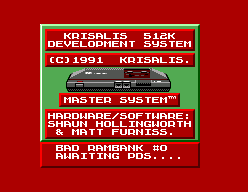
Interestingly, if the BIOS is treated as a Game Gear ROM rather than a Master System ROM, the following is displayed: 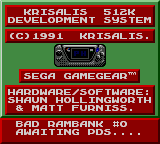
This confirms that the development system was designed to work with both the Master System and Game Gear. Presumably connection to a Game Gear would be via a Master Gear converter (which would have to be modified to avoid switching the GG into SMS-compatibility mode). The BIOS uses the following code to detect whether it is connected to an SMS or a GG: 01 00 00 ld bc,0000h
ED 78 in a,(c) ... E6 1F and 1Fh 28 XX jr z,game_gear If the lower 5 bits read from port $00 are all zero, the system is detected as a Game Gear, otherwise as a Master System. Note that this detection algorithm does not work correctly in MEKA - in SMS mode port $00 seems to always return a value of $00. A few more initial observations:
|
|
|
|
|
|
|
| The GG BIOS similarly detects the mode so it can display the splash screen in SMS mode, but does it in a completely different way. | |
|
|
|
|
|
Interesting. Also see http://www.smspower.org/Development/WonderBoyInMonsterWorld-SMS I'll make sure that it works better. I added a stub page for the software http://www.smspower.org/Games/KrisalisDevelopmentSystem-SMS |
|
|
|
|
|
|
|
Somewhat related "ESYS-RGB adaptor" from Games World magazine issue #1 (July 1994).
|
|
|
|
|
|
|
| I don't know if it's of any interest to anyone, but I actually have the Spidersoft box. Don't have all the PCB boards though. I have one I think for Master System/Game Gear, NES, and maybe Sega Genesis. I have a picture of it though. | |
|
|
|
|
|
|
Would be wonderful if you could post pictures, whatever hasn't been pictured above :)
I'd also be interested in buying any SMS/GG related development item. |
|
|
|
|
|
|
|
I've no idea if this is compatible, but I have a version of KASMZ8E and KASMBOY that was used with the ESYS systems. I managed to recover this off an ancient floppy disk recently.
There are incldue files which may give some pointers on how watches and breakpoints worked. I've also attached the ESYS tool which was used to upload and download ROMs to the device, so if one ever turns up in the wild you'll at least have something you can drive it with. :) |
|
|
|
|
|
|
|
Was this dumped BIOS ever made public?
And if not, any chances that it will? |
|
|
|
|
|
|
|
I guess not yet - maybe we should release it. It’s a bit useless without any hardware or course :)
I’d call it an IPL or bootloader rather than a BIOS, but we also call the SMS loaders BIOSes… |
|
|
|
|
|
|
If the hardware gets properly documented, there's always a chance that it could eventually make its way to MAME. |
|
|
|
|
|
|
| RetroSpark said they would release it (and got permission to do so) but didn't so far. | |
|
|
|
|
|
| If permission is already granted and he's not around anymore, maybe somebody else can release it? | |
|
|
|
|
|
| I'm still around, at least occasionally. I'll send the BIOS ROM dump to Bock so that he can release it on the website. | |
|
|
|
|
|
Awesome, thank you very much! |
|
|
|
|
|
|
Yay! We'll be sure to take a look at it once it's released. ~Cherri |
|
|
|
|
|
|
Hey uh... Not to be that person, but is anything ever going to come of this? Because the Krisalis 512k development system BIOS has been MIA for over seven years and I'm starting to think think it's going to remain that way forever. ~Cherri |
|
|
|
|
|
|
| Thanks for the reminder. I have now sent the BIOS ROM dump to Bock, along with some information to be turned into an SMS Power news post. | |
|
|
|
|
|
Oh cool! Thank you for doing that. ~Tammy |
|
|
|
|
|
|
| I'm surprised nothing's happened with this as far as I can tell. It really seems quite interesting. | |
|
|
 |

